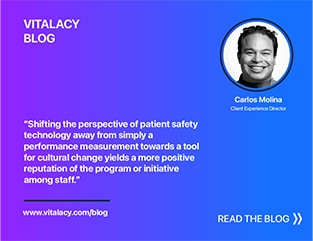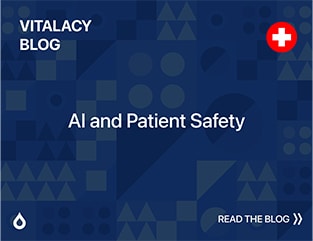In an acknowledgement of electronic compliance monitoring becoming an “important component of a comprehensive hand hygiene program,” the Leapfrog Group added electronic monitoring to its hand hygiene practice standards for 2019. Identified as a primary intervention to prevent healthcare-acquired infections (HAIs), high rates of hand hygiene compliance can reduce HAIs (Kelly et al., 2016; Pronovost et al., 2006; Vitalacy, 2019).

Leapfrog’s hand hygiene expert panel conducted a review of the literature and found a common theme: the use of multimodal strategies to improve hand hygiene, including electronic compliance monitoring, observations, and training/education.
The practice standards call for the current use of an electronic compliance monitoring system or plans to implement one within three years in inpatient, outpatient and/or emergency department units. Electronic compliance monitoring systems include systems that include the wearing of electronic badges, door minder or activity monitoring systems, or camera-based systems. Evidence for this measure can be found in the Leapfrog Group’s hand hygiene standard bibliography.

Early but compelling evidence shows electronic monitoring offering results superior to observation
Leapfrog’s new standard particularly highlights electronic compliance monitoring, which early but compelling evidence suggests offers results superior to observation for many types of hand hygiene compliance (such as hand washing and the use of alcohol-based hand sanitizer). As hospitals adopted computerized physician order entry (CPOE) systems and bar code medication administration systems (BCMA), Leapfrog expects health care organizations to incorporate the best possible solutions to safety problems that endanger patients.
Adapted in part from the World Health Organization’s Hand Hygiene Self-Assessment Framework, the new standard was developed by the Leapfrog Group working in collaboration with a National Hand Hygiene Expert Panel to understand what elements are most important and relevant for U.S. hospitals.
Members of the panel are:
- John Boyce, M.D., Boyce Consulting LLC;
- Elaine Larson, Ph.D., R.N., Columbia School of Nursing;
- Daniel Morgan, M.D, University of Maryland School of Medicine;
- Janet Glowicz, Ph.D., R.N., Centers for Disease Control and Prevention
- Emily Landon, M.D., University of Chicago Medicine.
In addition, the Leapfrog Group has a contract with the Armstrong Institute for Patient Safety and Quality at Johns Hopkins Medicine to provide scientific expertise and content management.
Schedule a demo with Vitalacy for solution demonstration.

Vitalacy Hand Hygiene Solution Dashboard
Monitoring and feedback as one of four new practice standard areas for Hand Hygiene Standards
The new practice standard of electronic monitoring compliance systems comes as part of four new general practice areas: training and education, infrastructure for supporting hand hygiene, monitoring and feedback, and additional questions (for fact finding only).
A few of these standards include:
- Collect at least 200 hand hygiene opportunities per month in each or ASC
- Provide feedback on hand hygiene compliance data
- Use hand hygiene compliance data for creating action plans
- Provide feedback on hand hygiene compliance data to hospital or ASC leadership
- Holding leadership accountable for hand hygiene performance through performance reviews or compensation
The electronic monitoring standard calls for the hospital to validate the accuracy of the data collected by the compliance system. Leapfrog experts the data to identify opportunities for hand hygiene improvement, to be used to create unit-level action plans, and to provide feedback to staff at least monthly for improvement work. The standard also calls for the system to be able to determine who practiced hand hygiene and verify when they practiced it.
The Vitalacy Automated Hand Hygiene Monitoring Solution enables hospitals to meet all of these standard requirements.

Electronic monitoring is key to closing one of the identified gaps in hospital performance: the under-sampling of observations. There is a consensus that the number of observations in most facilities in too low (Boyce, 2017; Gould et al., 2017; McCalla et al.; 2017; Vitalacy, 2019).
When care providers are not being directly observed, compliance drops off, due to the Hawthorne effect. Simply put, the Hawthorne effect – the alteration of behavior by the subjects of the study due to their awareness of being observed – greatly increases estimated hand hygiene compliance rates. Studies show the overestimation to be as high as 300 percent because compliance drops off significantly when healthcare workers are not directly observed, and most hand hygiene events are not directly observed (Hagel et al., 2015; Srigley et al., 2014). The CDC (2017) estimates that on average healthcare providers wash their hands less than half of the times they should.
Leapfrog plans to score and publicly report the new hand hygiene practice standard in 2020
In 2020, Leapfrog anticipates scoring and publicly reporting the new hand hygiene practice standard, which will replace Safe Practice 19 in the 2020 Leapfrog Hospital Survey and Hospital Safety Grade in fall 2020. Hospitals will earn different scores for the following scenarios:
- Electronic Compliance Monitoring System only
- Direct Observation only
- Electronic Compliance Monitoring System + Direct Observation
Read more about the Leapfrog Group’s new hand hygiene practice standards and learn how Vitalacy can help you meet them by scheduling a complimentary platform demonstration.
References
Boyce JM. State of the Science Review: Electronic monitoring in combination with direct observation as a means to significantly improve hand hygiene compliance. American Journal of Infection Control, May 2017;45(5):528-535.
Centers for Disease Control and Prevention (CDC). Clean hands count for safe healthcare. (2017).
Gould D, et al: Impact of observing hand hygiene in practice and research: a methodological reconsideration. Journal of Hospital Infection, 2017;95(2):169-174.
Hagel S, et al: Quantifying the Hawthorne effect in hand hygiene compliance through comparing direct observations with automated hand hygiene monitoring, Infection Control and Hospital Epidemiology, August 2015;38(8):957-62.
Kelly JW, et al: Electronic hand hygiene monitoring as a tool for reducing health care-associated methicillin-resistant Staphylococcus aureus infection. American Journal of Infection Control, 2016McCalla S, et al: An automated hand hygiene compliance system is associated with improved monitoring of hand hygiene. American Journal of Infection Control, May 2017;45(5):492-497.
McCalla S, et al: An automated hand hygiene compliance system is associated with improved monitoring of hand hygiene. American Journal of Infection Control, May 2017;45(5):492-497.
Pronovost P, et al: An intervention to decrease catheter-related bloodstream infections in the ICU. New England Journal of Medicine, 2006;355:2725-32.
Srigley JA, et al: Quantification of the Hawthorne effect in hand hygiene compliance monitoring using an electronic monitoring system: a retrospective cohort study, BMJ Quality & Safety, Dec. 2014;23(12):974-980.
Vitalacy, Inc. Finding new ways to prevent healthcare-acquired infections and conditions. Mar. 14, 2019.
Author
-

Janel Nour-Omid was inspired to start Vitalacy after losing her grandfather to a Healthcare-Acquired Infection. Through her background in computer science and product development and deep fascination in human behavior, she launched the Vitalacy platform designed to protect caregivers and patients from preventable infections and conditions. She was recognized in Forbes 30 Under 30 in Healthcare in 2020.



